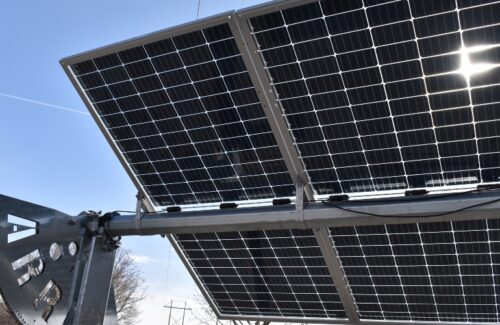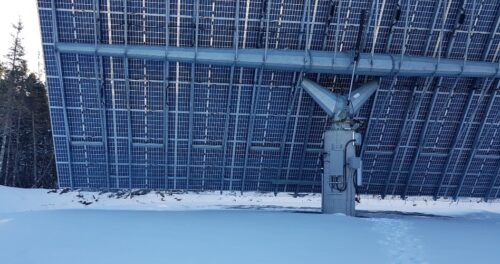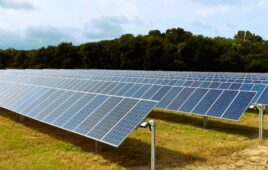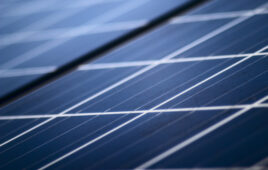Solar trackers promise greater energy yield than their fixed-tilt counterparts because they keep modules constantly pointed toward the sun throughout the day. Similarly, bifacial modules can produce more power than their one-sided solar panel cousins because they have double the exposure level.

A dual-axis tracker from Mechatron Solar was installed using bifacial modules. Stephen Mildenberger
So, is there a benefit to pairing two technologies that each ensure greater solar yield? Some tracker manufacturers believe there is. At the very least, bifacial modules will generate more energy than their frontside power rating. When combined with certain environmental and design conditions, backside generation can be boosted even more.
Bifacial cells made up 50% of the world market share of solar cells in 2021, and that percentage is expected to increase to 85% by 2023, according to the International Technology Roadmap for Photovoltaics. Additionally, tracker manufacturers reported that the large majority of recent solar projects using their tracking systems include bifacial panels.
Besides the benefit of extra backside generation, the bifacial exemption from Section 201 trade tariffs has likely contributed to the technology’s proliferation in the market. But tracker manufacturers aren’t all in agreement on how to prioritize backside optimization.
“Your mileage may vary, and you need to do the math and figure out what’s best for a given project,” said Matt Kesler, director of solar technology at OMCO Solar. “The extra production that you get from bifacial is usually a good investment.”
Rotating solar irradiance on one axis
Single-axis trackers have quickly become a standard in utility-scale solar projects. They can be installed in similar project footprints to fixed-tilt racking, with the added production bonus of row-by-row movement to track the sun throughout the day.
The mechanisms that drive solar trackers and the controls that optimize positioning for energy generation and weather conditions vary by product. Manufacturers often develop in-house control software to accompany their trackers, but directing that software to focus bifacial arrays on backside generation isn’t necessarily the best move.
Array Technologies, a global manufacturer of single-axis trackers, tested optimizing backside irradiance gain with its proprietary control software SmarTrack. During the test and accompanying simulations, the company found that the energy difference between an array running typically and one focusing on backside generation was just 0.1% over a year.
Array found that the system moved erratically, rotating up and down almost hourly to encourage backside rather than frontside generation gains. The backs of bifacial modules are not as efficient as the front, so Array believes the focus should remain on frontside optimization.
“It’s always beneficial to try to maximize the irradiance from the sky with the front side,” said Kyumin Lee, VP of engineering for research and technology at Array Technologies. “That’s the best approach, because if you try to improve backside irradiance but lose on the front side irradiance, you will probably not see any gains, or you would likely run into scenarios where you actually lose energy.”

Credit: Array Technologies
Like system controls, designs for single-axis solar projects with bifacial panels can remain the same as monofacial projects. Ground albedo (or reflectiveness) can be increased with larger row spacing between trackers, meaning there will be less shadowing and more reflected irradiance.
However, increasing row spacing to encourage higher albedo will increase the overall footprint of a solar project.
“Between tracker and tracker, if you have a larger row spacing, there’s more ground that can reflect light. So, yes, you can have higher bifacial gain, but I think my argument there was always that at the end, it’s not bifacial gain that’s paying the bills,” Lee said. “It’s the total energy produced.”
In many cases, bifacial generation should be treated as unexpected bonus gains. Additional energy generated from the back with larger row spacing likely will not account for the cost of the larger land mass used to accommodate it.
White surfaces like snow and crushed limestone can increase ground albedo — snowfall happens naturally, but the latter requires additional site preparations and capital.
Then there’s the design of the tracker structure itself. Array’s DuraTrack HZ v3 installs modules in one-in-portrait orientation. It uses a “high-rise” bifacial module clamp that clears the panel’s junction boxes and includes additional spacing between the back of the module and the torque tube (the pipe that rotates the panel row) compared to its other clamp models.
Array tested how the torque tube affected backside shading on portrait-oriented bifacial modules and found it had little effect on generation.
“There are much larger contributing factors to how the PV plant produces energy related to a bifacial module, such as view factor and then things that are a little bit out of control, like the albedo,” said Cody Norman, director of applications engineering at Array Technologies.
National solar racking and tracking manufacturer OMCO Solar had a different take on the effects of shading caused by torque tubes. The company produces OMCO Origin Factory-Direct Trackers, which have a two-in-landscape panel orientation with a torque tube that runs between the bifacial modules rather than behind them.
The company’s strategy is supported by a 2019 study by the National Renewable Energy Laboratory, Sandia National Laboratories and Cypress Creek Renewables that found torque tube shading reduced backside generation on bifacial modules from 2 to 8%. In individual tests, OMCO found the shading effect was greater than reported.
“Even though the average irradiance is reduced by 8%, the irradiance on some of those cells is reduced by more than 20%,” OMCO’s Kesler said. “Since the cells are in a series, you can’t put more current through some of the cells and less through the others. You can only put the same amount of current through all the cells. If you pull down a few of the cells by more than 20%, you’re pulling down the whole backside by more than 20%.”
Single-axis solar tracker choice and project design is left to the discretion of the system owner. Bifacial backside generation is a given on these projects, but certain design choices made to encourage additional generation can have the tradeoff of reducing frontside generation.
Double-sided cells on dual-axis trackers
Dual-axis trackers pivot on two points, making them able to directly track the sun throughout the day, unlike single-axis trackers that pivot on one.
Dual-axis trackers are installed atop single posts and can hold upwards of 20 panels per unit. These systems are typically deployed in commercial and residential settings and stand taller than single-axis trackers. That greater distance from the ground has proven beneficial for bifacial modules.
AllEarth Renewables, a dual-axis tracker manufacturer, partnered with Sandia National Laboratories to study how bifacial modules performed on trackers in the northern United States, specifically in Vermont where the company is based. The two-year study resulted in a report that found bifacial modules outperformed monofacial modules installed on the same dual-axis tracker at an average of 14% annually. During winter months, that number leapt to 40% because of the high albedo of snow cover.

Ground cover like snowfall creates a higher albedo than other natural surfaces, which can result in higher backside gains for bifacial modules. Stephen Mildenberger
“So far, our data is matching what the predictions are — that we’re getting pretty darn good production in our environments up here,” said David Blittersdorf, president and CEO of AllEarth Renewables.
Dual-axis trackers are often installed in northern states because they can adapt to the territory’s terrain and annual snowfall. Another benefit the study found during winter months was quicker snowshed because of the motion of dual-axis trackers and the translucency of double-glassed bifacial modules.
Due to their height and greater spacing compared to single-axis trackers, more radiant light surrounds dual-axis trackers, leading to more opportunities for backside generation with bifacial modules.
Mechatron Solar, a dual-axis tracker manufacturer, uses table-level reflectors on its M18KD tracker to direct light to the backs of bifacial modules. The company reported a 13 to 15% boost in gains using the reflector instead of conventional ground cover in Northern California.
“We recognized not only that [bifacial] technology is breakthrough, but also that the dual-axis mechanism would achieve higher bifacial boost than either fixed-tilt or single-axis trackers, since our dual-axis follows the sun across both zenith and azimuth axes, unlike the competition,” said Michael Fakukakis, CEO of Mechatron Solar.
Regardless of the structure, there is extra solar production to be gained from using bifacial modules on solar trackers. Weighing the cost and design considerations can help contractors decide when the combination is a good fit.




The main issue with bi-facial panels on a tracker is that the support should not cover the cells on the back. Any cable, or metal pipe will create a shadows ruining the effort of producing electricity from this side.
I have tried to design the cheapest tracker possible here youtu.be/uGfn9DSRMd0 but would love to see if it’s possible to get one with no support on the backside. Let me know if you could help pointing me on such project.
thanks
Study placing 2 sided solar panels vertical to the sun with mirrors attached at the bottom to the of the panel reflecting back on each side. I think the spacing of spacing of panels would be less and exposure to both sides far more efficient when using trackers.
The AllEarth dual-axis trackers may only support 20 panels, but the Mechatron Solar dual-axis trackers support 90, at a much higher table elevation, thus with much higher bifacial boost. Very big difference in yield.
I like the photo’s of my 2-axis tracker. If you want more info for a future article, let me know.